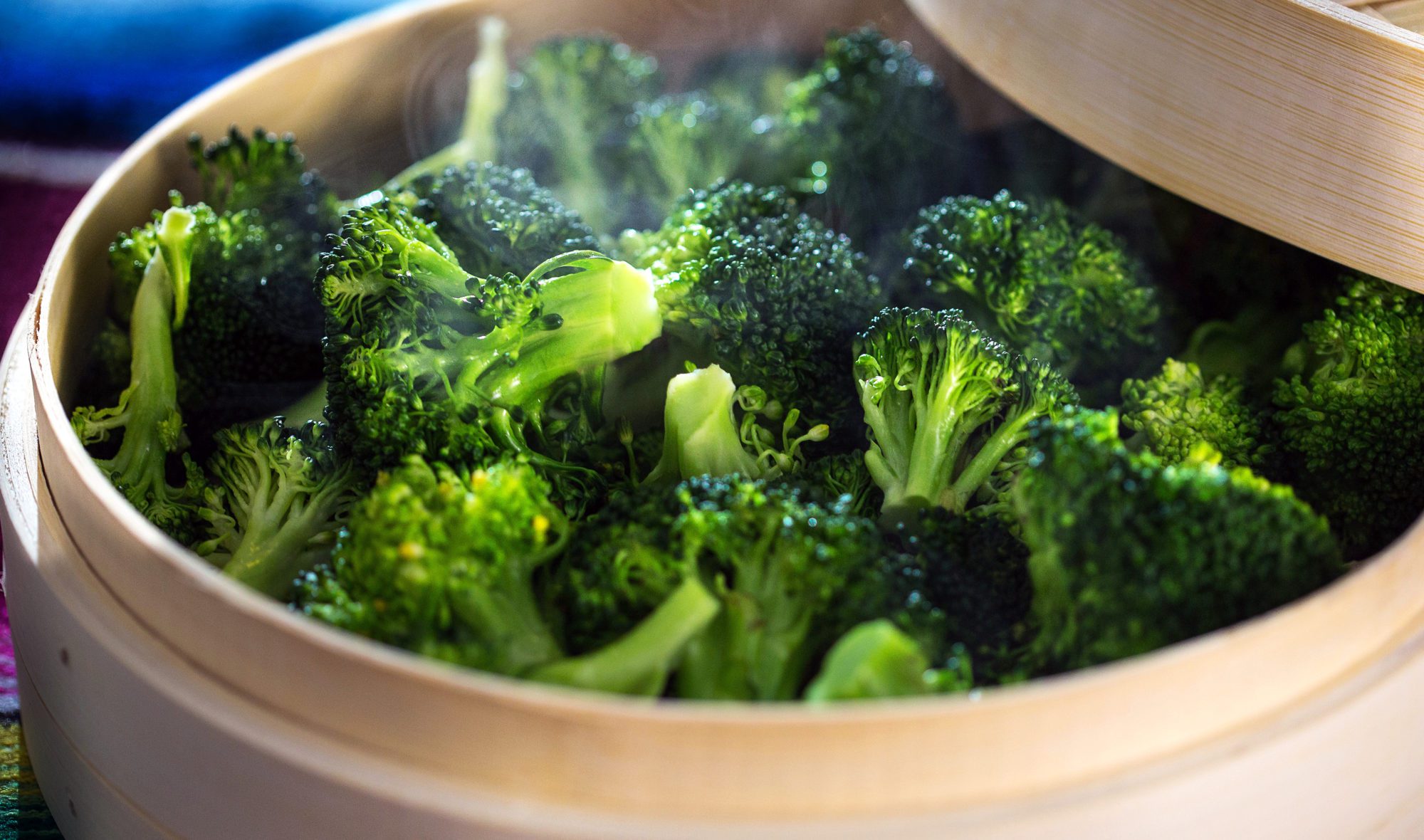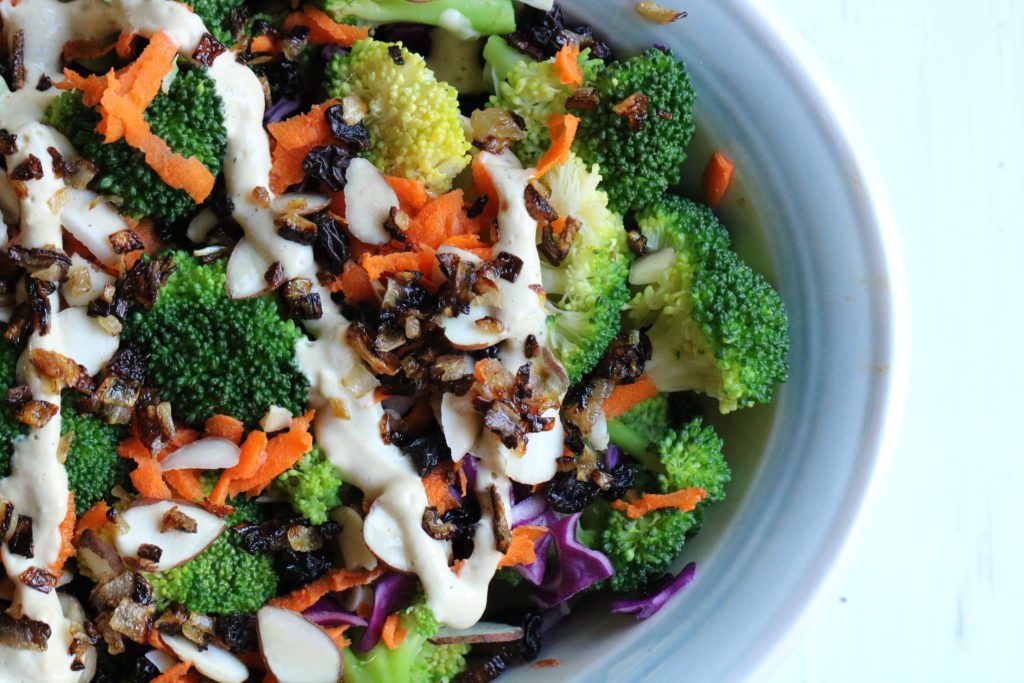
🎁 Holiday Special: SAVE 52% on the Nutrition Coach Starter Package. Limited number remaining.

🎁 Holiday Special: SAVE 52% on the Nutrition Coach Starter Package. Limited # left.

Broccoli is a perfect prop if you are pretending to be a tree-eating giant. Appearing much like a tree on a smaller scale, broccoli has a firm trunk that branches out into little flowery green buds. Broccoli is very nutritious, and in addition to being an excellent source of vitamin C and vitamin K, the plant also contains a variety of other health-promoting phytochemicals such as sulforaphane, kaempferol, and isothiocyanates. The flavor of broccoli varies slightly depending on whether it is served raw or cooked: Raw, broccoli is mildly sweet with a deep green, slightly bitter, cabbage-like flavor. Cooked, the sweetness lessens and the vegetal flavor becomes more pronounced, becoming sulfurous if overcooked. In addition to being a wonderful addition to salads and stir-frys, broccoli is a notably superior vehicle for dip.
Being a nearly perfect scaled-down version of a tree, broccoli is especially fun to eat when pretending to be a dinosaur eating vast expanses of forest.
Broccoli is a member of the Brassica family, which includes other vegetables like kale, cabbage, and broccoli’s pale twin, cauliflower. Like many members of this family, broccoli grows well in slightly cooler temperatures.
Broccoli has sometimes been called a “superfood”. While we don’t like to idolize vegetables, broccoli does contain a variety of powerful health-promoting phytochemicals, such as sulforaphane, kaempferol, and isothiocyanates, which are plant compounds that have detoxifying, antioxidant, and anti-inflammatory properties.
Broccoli has its roots in Italy, where it was developed from a species of wild cabbage, and its Italian name, broccolo, means “cabbage sprout”. Eventually, broccoli was brought to North America and popularized by Italian immigrants. So, much to the internal conflict of children around the world, we can thank the Italians for both pizza and broccoli.
Broccoli looks like a tiny tree, with a hearty edible stalk branching out into miniature buds. Typically, the plant is a muted green color, although certain varieties display a green-to-purple ombre hue.
Broccoli can be eaten raw or cooked. Raw broccoli has a mild sweetness overtop a deep green, slightly bitter, cabbage-like flavor. When cooked, this sweetness lessens and the vegetal flavor becomes more pronounced, becoming sulfurous if overcooked. In its raw form, the broccoli stalk is crunchy and slightly fibrous, and the buds are softer and flowery. Cooked, it becomes tender and turns bright green.
Although many people discard the stalk, it is edible too, and quite tasty, so long as the fibrous outer layer is peeled off.
One cup of chopped, raw broccoli (about 91.0g) has 31 calories, 2.6g protein, 0.3g fat, 6.0g of carbohydrates, 2.4g fiber, and 1.6g sugar. Broccoli is an excellent source of vitamin C (in its raw form) and vitamin K.
As previously mentioned, broccoli also contains a host of other antioxidant, anti-inflammatory, and detoxifying compounds, such as sulforaphane, kaempferol, and isothiocyanates.
Broccoli is a common vegetable and is easy to find both fresh or frozen (typically pre-chopped and blanched for convenient preparation), in most grocery stores.
When buying fresh, whole broccoli, look for heads that are compact and firm and free of yellowing, bruising, or slimy spots. If the stalk and leaves are attached, they should look fresh and firm too.
If buying packaged broccoli, read the ingredients. Fresh or frozen packaged broccoli should contain only one (rather obvious) ingredient: broccoli.
Broccoli can be stored in the fridge, wrapped tightly in a plastic bag, for up to 10 days. To maintain or restore turgidity, broccoli can be placed, freshly-cut stalk down, in a shallow mug or bowl of water for a couple of hours. Cooked broccoli will stay fresh in an airtight container in the fridge for three or four days.
Broccoli can also be frozen, although it should be blanched before freezing to prevent the unpalatable rubbery texture of broccoli that’s been frozen raw and then cooked. Blanched, frozen broccoli will keep in the freezer for about six months.
In order to eat broccoli, first give it a wash under cool, running water.
Then, trim off the very end of the stem, and slice the stem from the head of florets. Separate the florets into even-sized pieces, using a knife or tearing them apart with your hands. Peel off the outer, fibrous skin of the broccoli stem, and cut the stem in desired shapes.
Your broccoli can be eaten raw at this point, either thrown into salads or used as a vehicle for dip. Alternatively, you can also cook your broccoli either by steaming it, roasting it, or tossing it in a stir-fry.

Forget the cheese sauce – this broccoli is smothered in a smooth and spicy whipped sauce made from the healthy fats in sunflower seeds. Along with a bit of spice from cayenne pepper and a bit of crunchiness from caramelized shallots – you’ll be saying cheese who?
Prep Time: 10 minutes Cook Time: 5 minutes Yield: 4 servings
Chop broccoli into some florets and bring a medium pot to boil with about 1 inch of water. Once boiling, add broccoli and steam covered for 2 minutes. Remove from heat, drain water immediately and add broccoli to the bowl you will be serving the salad in to remove it from any heat.
Slice and chop the red cabbage and peel and shred carrot. Set aside.
Heat 2 tsp butter in a small skillet. Finely dice the shallot and cook until browned and slightly crunchy, even burning it slightly.
In a food processor, add all the sauce ingredients except the water. Blend well for 30 seconds until it looks whipped. Gradually add 2-3 tbsp of water to make it light and fluffy – it will not be the consistency of a salad dressing, it will be more like whipped cream.
In the large bowl where the broccoli is, add the cabbage and carrot and toss with dressing – add the dressing gradually, just enough to coat the vegetables lightly. Then top with almonds, currants, and shallots.
Precision Nutrition’s Encyclopedia of Food expands every single month as we highlight new foods and showcase beautiful food photography. If you’d like to stay up to date, simply click this link. From there, we’ll send you a FREE copy of our recipe book. We’ll also let you know when new and delicious foods are added to the site.
Broccoli is a perfect prop if you are pretending to be a tree-eating giant. Appearing much like a tree on a smaller scale, broccoli has a firm trunk that branches out into little flowery green buds. Broccoli is very nutritious, and in addition to being an excellent source of vitamin C and vitamin K, the plant also contains a variety of other health-promoting phytochemicals such as sulforaphane, kaempferol, and isothiocyanates. The flavor of broccoli varies slightly depending on whether it is served raw or cooked: Raw, broccoli is mildly sweet with a deep green, slightly bitter, cabbage-like flavor. Cooked, the sweetness lessens and the vegetal flavor becomes more pronounced, becoming sulfurous if overcooked. In addition to being a wonderful addition to salads and stir-frys, broccoli is a notably superior vehicle for dip.